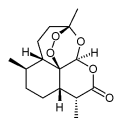Artemisinin
Artemisinin is a drug used to treat multi-drug resistant strains of falciparum malaria. The compound (a sesquiterpene lactone) is isolated from the shrub Artemisia annua long-used in Traditional Chinese Medicine. Not all shrubs of this species contain artemisinin. Apparently it is only produced when the plant is subjected to certain conditions. more...
Cancer Treatment
Artemisinin is also under early research and testing for treatment of cancer. Artemisinin has a peroxide lactone group in its structure. It is thought that when the peroxide comes into contact with high iron concentrations (common in cancerous cells), the molecule becomes unstable and releases reactive oxygen species. It has been shown to reduce angiogenesis and the expression of vascular endothelial growth factor in some tissue cultures.
History
Artemisia has been used by Chinese herbalists for more than a thousand years in the treatment of many illnesses, such as skin diseases and malaria. In the 1960s a research program was set up by the Chinese army to find an adequate treatment of malaria. In 1972, in the course of this research, Tu Youyou discovered artemsinin in the leaves of Artemisia annua. The drug is named qinghaosu (青蒿素) in Chinese. It was one of many candidates then tested by Chinese scientists from a list of nearly 200 traditional Chinese medicines for treating malaria. It was the only one that was effective.
It remained largely unknown to the rest of the world for about 10 years, due to the Communist Chinese government at the time. The rest of the world finally found out about the drug from an article in a Chinese medical journal. People were sceptical at first, because the Chinese had made unsubstantiated statements about having found treatments of malaria before. Another reason was the peroxide part of the molecule. It was thought unlikely this would be a stable molecule, and so would not last long enough to be effective. This turned out not to be the case.
The Chinese government at the time, however, was very wary of western scientists, and would not give anyone either the plant or the refined drug. People around the world now started looking for the shrub themselves, to see if they could find it. They finally found it along the Potomac river, in Washington, D.C. Apparently it was a very common shrub, found in many parts of the world--In fact, it was often treated as a garden weed. It took another 10 years of research before the drug finally became commercially available. By this time relations between Communist China and the rest of the world had improved, and scientific information could be exchanged.
The drug is used these days in China and Vietnam without much regard to taking precautions against creating resistance of the malaria parasite to this drug as well, but nevertheless no resistance has been encountered in these parts of the world. Because ot the method of action, it is unlikely that resistance to artemisinine and derivatives will become a problem in the near future.
Read more at Wikipedia.org



